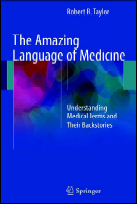Translate this page into:
The amazing language of medicine
Corresponding Author:
Sanjay A Pai
Department of Pathology and Laboratory Medicine, Columbia Asia Referral Hospital, Bengaluru, Karnataka
India
sanjayapai@gmail.com
| How to cite this article: Pai SA. The amazing language of medicine. Natl Med J India 2019;32:249 |
The Amazing Language of Medicine. Robert B. Taylor. Springer, Heidelberg, 2017. 238pp, €58.84 (eBook), €72.79 (Softcover). ISBN: 978-3-319-50327-1.

Medicine has a rich history, but few of us realze that so does its vocabulary. Our initiation to the sometimes maddening words is when we are exposed to and struggle with anatomical terms. Thus, it is logical to assume that much of the vocabulary is from Latin. But, there is much more to it, and this book delves into the subject. We learn from it that Roy Butler has shown in 1980, analysing almost 49 500 words from the 24th edition of Dorland’s illustrated medical dictionary that 58.5% of medical terms are from Greek, 21.8% from Latin and 2.9% from English. Taylor elsewhere in this book adds that Neosalvarsan is a unique example as it has roots in Greek, Latin and German.
Dr Taylor, who is clearly gifted, given that he is the author of many books including Medical writing tells us the fascinating stories behind these words from different cultures, languages and contexts. For this, he makes extensive use of the most varied sort of literature. I have an obvious interest in the subject[1] and particularly enjoyed reading the book.
The book is a fount of medical lore and information. I learnt that there are 640 muscles in the human body, that the sphenoid (‘Damn the sphenoid bone’, to quote Oliver Wendell Holmes) has more separate facts (60 of them) to learn than any other bone in the body save the temporal bone (with 64 facts) and that the sacrum is considered a holy bone. He offers entirely new possibilities for the reason the sartorius muscle is named after tailors. I was most astonished to discover that essential hypertension was called so because it was believed—at least until 1937—to be ‘essential’, meaning ‘necessary’, because it was ‘an important compensatory mechanism which should not be tampered with’ because it was necessary to propel blood through sclerotic arteries.
We are made aware of how literature (Alice in Wonderland syndrome, Pickwickian syndrome, etc.), the Bible (Job syndrome, placebo) and popular culture (Orphan Annie nucleus of papillary carcinoma of the thyroid, naming of the drug rifampicin), have contributed to the rich vocabulary of medicine. We are told why Papanicolaou of Pap stain was not awarded the Nobel Prize and that the (now-not-recognized) Colles law was a profound error in the understanding of syphilis. Speaking of which, why ‘the clap’ (gonorrhoea) is called so as also the etymology of the word ‘fornicate’ (and vaginal ‘fornix’) is also explained.
Reading this book is also a good way of refreshing one’s knowledge of medicine. For example, he informs us that Pityriasis rosea may be misdiagnosed as a fungal infection or as secondary syphilis. It is also fascinating to learn delicious non-medical trivia such as the reason behind the naming of Starbucks (the chain of coffee houses) or the origin of the word ‘quark’ in nuclear physics.
Dr Taylor is honest but diplomatic, and readers would have to read between the lines to understand that he gives credit to Albert Schatz but not to Selman Waksman for the discovery of streptomycin. He even shows which side of the divide he stands on in the use of the term patient versus client/customer when he quotes W. Clay Jackson: ‘Every time a doctor calls a patient a customer, an angel dies’ (italics in original).
A book such as this would, of course, carry some errors, and this book is not immune to them. The author refers to anchovy sauce stools in amoebiasis (p. 99), but in reality, it is anchovy sauce pus (in the liver) of amoebiasis. Occasional typographical errors exist such as Tomas Wharton instead of Thomas Wharton, Thomas Osler instead of William Osler, who was born in 1849 and not 1848, Pierre Curie (1859–1906 and not 1895–1906), Aspirin (developed in 1897 and not 1898) and Crawford Long (who used anaesthesia first not in 1841 but 1842) and 1926 instead of 2926 as the year in which Victor Babes died. There is a mention of a book by Orient on page 179, but the reference is missing in the bibliography.
Future editions of this book could also include the terms Brainerd diarrhoea, information about the injustice done to Theobald Smith who discovered the bacteria now named Salmonella,[2] material about Lex cesare and the rare Neil Armstrong syndrome and Christchurch chromosome, as also more information about the delicious gossip and anecdotes behind the naming of Crohn disease.
| 1. | Hussain M, Pai SA. Geographic eponyms: A history of geography in medicine. Natl Med J India 2016;29:166-8. [Google Scholar] |
| 2. | Pai SA. Veterinarians as scientific contributors—and a plea to rename Salmonella as Smithella. Curr Sci 2019;116:157. [Google Scholar] |
Fulltext Views
876
PDF downloads
265




